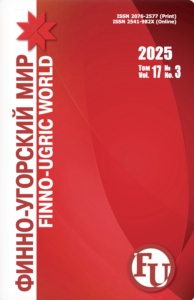DOI 10.15507/2076-2577.010.2018.01.029-035
The grammer of the Hungarian language etiquette (in the Hungarian language textbooks)
Antonina P. Guskova,
Candidate Sc. {Philology}, Associate Professor, Department of Finno-Ugric Philology, Lomonosov Moscow State University
(Moscow, Russia), guskova_ant@mail.ru
Features of Finno-Ugric languages’ (including Hungarian) are a relevant problem of Finno-Ugric Studies in general. The article describes the features of Hungarian speech etiquette from comparative linguo-pragmatics [Hungarian as a foreign language (HFL)] point of view. The method seems to be promising in the light of grammatical specificity both of Russian and Hungarian, appealing to advanced grammar course of HFL and communicative skills acquisition as well.
The article highlights grammar correlation between Russian and Hungarian language systems and is based on grammar comparison of both languages. Pragmatics, semantics of syntax and comparative linguistics methods are used in this article. Modern Hungarian language dictionaries are involved to analyze lexicographic definitions. The materials of the research consist of sampling Hungarian prose, newspaper and grammar vocabulary excerpts as well as the interviewers with Hungarian native speakers.
The complex research of Hungarian speech etiquette can make up for a deficiency that is still to be in relevant chapters of HFL methodic literature. Comparative analysis is to designate versatile (systematical and functional) traces in speech etiquette grammar and to determine the differences of Russian and Hungarian languages. That is the key point to solve the problems aligned with practice of teaching HFL.
The research demonstrates intercategorical connections supplied in etiquette forms are integrated into single system that has a line of grammatical specificities of actualization in speech etiquette and related with certain parts of speech. This system reflects primary distribution of pronominal, nominal and verbal characteristics inside determined forms. The sophistication of etiquette forms in Hungarian permits us to conclude there is a necessity of incorporation speech etiquette into Hungarian course book (as an independent part). This idea is precisely approved by the fact that there is a lack of complete and systematical descriptions of Hungarian syntax pragmatics.
Key words: Hungarian language, speech etiquette, etiquette specificity, grammatical features, pronominal forms of address, nominal forms of address, verbal forms of address.
For citation: Guskova AP. The grammer of the Hungarian language etiquette (in the Hungarian language textbooks). Finno-ugorskii mir = Finno-Ugric World. 2018; 10: 1: 29–35. (In Russian)






















